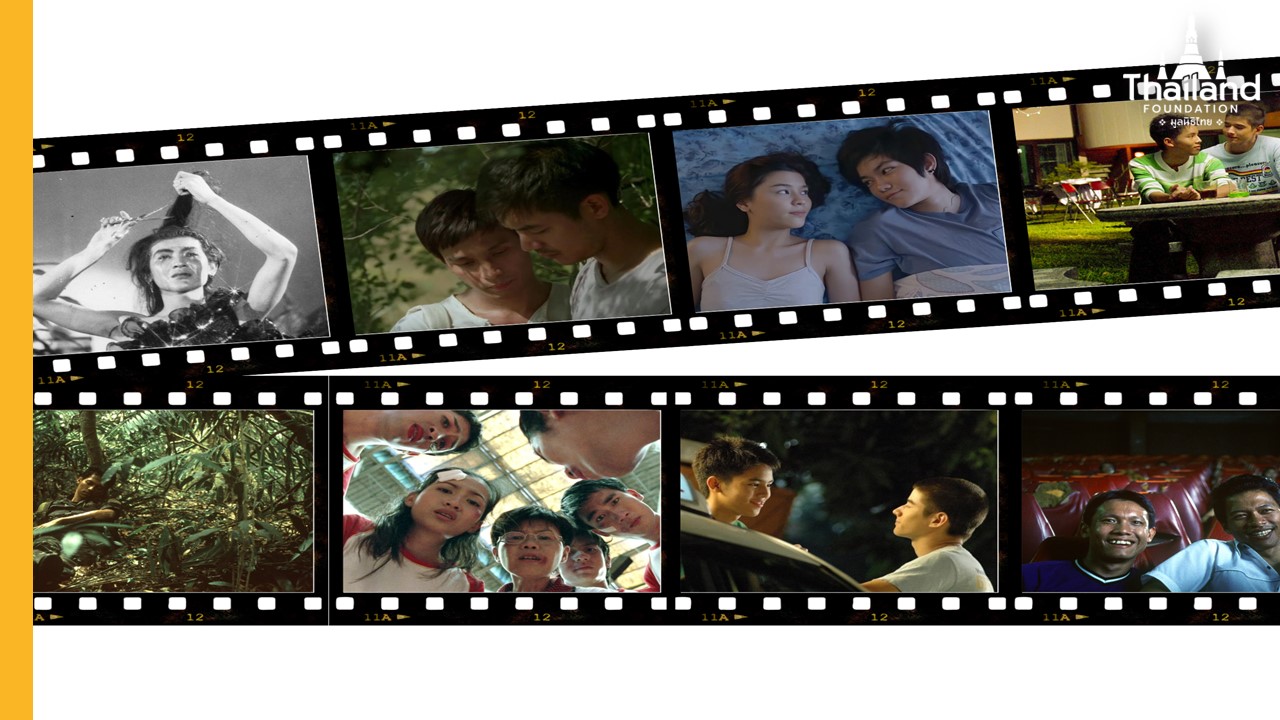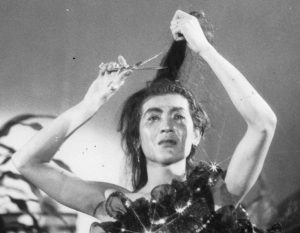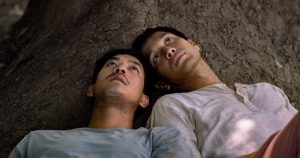The Evolution of Thai Queer Cinema: The Essential List
Contents

Thailand is known to be welcoming of people from various backgrounds, regardless of their culture or sexualities. Thailand’s openness is reflected in the daily lives of its citizen, transcending from people-to-people relations to cinema—a sphere wherein human’s thoughts are perpetually encapsulated. In terms of sexual diversity, Thai cinema has a long history of misrepresentation of LGBTQIA+ community. Early films such as It’s All Because of Katoey (1954), Koong Nang (1976) to Wai Rian Pian Rak (1985) all shed a misunderstanding on the issue, ranging from homosexuality being a social deviance to it not being real. Today, Thai media has progress more than it has ever been. It displays nuance experiences of the LGBTQA+ individuals in modern Thai society. To understand such complexity, the Thailand Foundation presents you six essential Thai queer films to journey through the progress of openness and understanding in Thai cinema.
1. The Last Song (1985)

Somying Daorai in The Last Song (1985)
Thai Title: เพลงสุดท้าย
Directed by Pisan Akaraseranee
Released in 1985, Pisan Akaraseranee’s The Last Song was one of the first features to put a trans woman on a leading role. The film ventures into the lives of transsexuals as stage performers, including their doomed romances. The story starts with a group of performers having their car broken down in front of a repair shop where they meet Boonterm (Bin Bunluerit), a repairman, for the first time. His dream to become a professional stage singer leads him to become romantically involved with Somying (Somying Daorai), a talented trans performer who introduces him to be on the stage.
As Boonterm ascends to fame, the romance between the two of them slowly burns out. His popularity over female fans anguishes Somying’s jealousy and consequently pushes Boonterm towards cheating. Things get worse when the film starts coupling Boonterm with Orn, a girlfriend of Praew (Jirawadee Isarangkul Na Ayudhaya), a lesbian member of the group. The couple spends days happily together, leaving their former lovers drowning in pain. Somying dedicates her last song to Boonterm and shoots herself afterwards on the stage.
Amidst the country’s prejudices towards LGBTQIA+, The Last Song was a groundbreaking moment, not only for Thai entertainment industry, but for the queer community as well. It resonates the complex and painful experience that the queers have to encounter in the mist of conservative 1980s, exploring into the hearts of the marginalized; not to mention that it gives roles for the real queer actors, such as Somying Daorai and Jirawadee Isarangkul Na Ayudhaya, to star in it as well.
That said, the film has it flaws. Despite its well-intended representation, it still falls behind the cliché where the queers can never find a real love—as seen from Somying and Praew. However, on a different perspective, while the tragedy is deemed to be stereotypical, it can read as the untold story of what real-life queers had to face in the era.
2. The Iron Ladies (2000)

The cast of The Iron Ladies (2000)
Thai Title: สตรีเหล็ก
Directed by Youngyooth Thongkonthun
The beginning of the 21st century sheds a new hope for the LGBTQIA+ representation in Thai entertainment industry. Youngyooth Thongkonthun’s The Iron Ladies broke out into the mainstream culture with the new representation of trans women, unlike its precedents that only assigned the LGBTQIA+ character to tragedy or comedic roles. Based on a true story, the film documents the success of a volleyball team, primarily consisting of queer and trans individuals, and their journey against social prejudices.
Seeing the recruitment notice of a male volleyball team, a trans woman Jung (Chaichan Nimpulsawasdi) invites her friend Mon (Sahaphap Tor) to apply for an audition. In spite of the binary of a gender border, their talent helps them get selected to be in the team alongside straight men, who could not be more bothered to be their colleague. The coach (Shiriohana Hongsopon), a lesbian whose talent is undermined, empathizes her supports for Mon and Jung, causing displeasure among the men. They consequently decide to quit the team. As a result, Mon and Jung goes around inviting their queer friends to fill up their spots. The team is later called “The Iron Ladies.”
While still maintaining the comedic and easy-to-follow narrative, The Iron Ladies coats it on an empowering message against homonormativity—the idea that people in LGBTQIA+ community have to prove themselves or act acceptable for their gender to be approved. The film rejects the idea and sends out the message to its audiences that they can be anything—successful or not—regardless of their gender. There is one scene where a queer and a straight character have a discussion about their dream and who they are. They finally come to the conclusion that they do not need the approval from the society nor success for them to be proud of themselves. Even if they fail the tournament, they will still be proud of who they are.
3. Tropical Malady (2004)

Banlop Lomnoi in Tropical Malady (2004)
Thai Title: สัตว์ประหลาด! (Monster!)
Directed by: Apichatpong Weerasethakul
“All of us are by nature wild beasts. Our duty as human beings is to become like trainers to keep their animal in check and even teach them to perform tasks alien to teach their bestiality” – Nakajima Ton, The Wild Beast
Originally titled Monster!, Apichatpong Weerasethakul prologues his audience with a quote from the famous Japanese writer Nakajima Ton about human nature. Apichatpong visualizes the concept through two folkloric stories that may seem unconnected to each other on a facade level. He strips the film into a quiet moment against the backdrop of Northeast region of Thailand.
In the first story, the film chronicles the brief romance that sparks between two men during their escapism on the verge of the forest. On his search for the job, the unemployed Tong (Sakda Kaewbuadee) runs into his acquaintance Keng (Banlop Lomnoi), a soldier. The two then spend time together wandering around the town and developing their relationship under that bubble, intact from any interference.
The second story follows a chasing game between a soldier (Banlop Lomnoi) and a deadly werecat (Sakda Kaewbuadee). It is said in the tale that to free its spirit, he must kill the monster. Despite such a premise, Apichatpong choses a different motif for his characters. The soldier, prevailed by the love and empathy for the werecat, chases the spirit, not to kill, but to bring it along with him to haven. He then camouflages himself into the nature and discover a spiritual wonders it stores.
Are the two stories connected to each other? That question is widely open to interpretation. Nevertheless, the ubiquitous theme of both stories is their reverberation of Nakajima’s The Wild Beast, where Apichatpong toys with the binary between civilization and nature. Given that the first story was set upon the boundary between a city and a forest, same-sex love between Tong and Keng therefore lingers on the liminality between normalcy and clandestineness. It ends melancholically one night with Keng walking away in the dark during their ride home. Comparatively, the characters in the second stories are different in their behaviors. Retreating in the depths of nature, they are beyond the reach of societal orders. As civilization fades down, nature embodies its creatures and exhibits their intuitive desire.
4. The Love of Siam (2007)

Witwisit Hiranyawongkul and Mario Maurer in The Love of Siam (2007)
Thai Title: รักแห่งสยาม
Directed by Chookiat Sakveerakul
Despite being recognized a gay love story, Chookiat Sakveerakul’s The Love of Siam’s main theme goes far beyond its public perception. It explores the feelings of displacement and wistfulness, telling the story through different perspectives from various character that is linked together by the thread of their sadness.
Siam, the commercial area, chronicles the vibrant lives of Bangkokian teenagers and their search for love. Mew (Witwisit Hiranyawongkul), a musically talented student, is one of them. His life story begins with the departure from his parents at a young age. Worse, his close neighbor, Tong (Mario Maurer), has to move away after his sister, Tang (Chermarn Boonyasak), went missing. Tong’s parents, Korn (Songsit Roongnophakunsri) and Sunee (Sinjai Plengpanich), could not handle the old memories that the familiar environment brings and decided to move to a new place. Korn becomes an alcoholic, and Sunee is forced to step up to take care of her family.
The two boys reunite years later when Tong accidentally runs into Mew at Siam, slowly developing their relationship and exploring their sexuality thereafter. At the same time, Sunee is introduced to June, Tang’s look alike, and hires her to be around in hopes that Korn’s mental health will improve. Unfortunately, the relationship between Tong and Mew hits a dead end when Sunee finds out about them. She forbids her son to speak with Mew ever again out of her own conservatism. She finally learns to accept it eventually, but the conscience of the forbidden homosexual love hinders their romance still.
Released in 2007, The Love of Siam is still acclaimed as one of the most beloved features, not only in queer cinema, but also in Thai cinema as a whole. It prisms a spectrum of human emotions as well as limelighting the true love that exists regardless of genders–even if it is forbidden. “If we can love someone so much, how will we be able to handle it one day when we are separated?.. is it possible that we can live our entire life without loving at all?” asks Mew.
5. Yes or No (2010)

Suppanad Jittaleela and Sushar Manaying in Yes or No (2010)
Thai Title: Yes or No อยากรักก็รักเลย
Directed by Sarasawadee Wongsompetch
Starting off a new semester, Pie (Sushar Manaying) is in shock to learn that her new roommate, Kim (Suppanad Jittaleela), is a tomboyish lesbian. Their first encounter does not go so well as Pie finds lesbians weird and deviant. She is al perplexed by Kim’s appearance, strolling the line between male and female.
Their relationship improves one night when Pie saw Kim cook roasted chicken with rice. She gets hungry by the smell and join her. They both get to know each other more and develop romance since. Nonetheless, their relationship is put to test multiple times. Sarasawadee Wongsompetch’s Yes or No digs into the struggle lesbians have to encounter, not only against homophobia, but also patriarchy. The case is worse for Kim, who has to fight through both catcalling behavior and discrimination from straight men. Interestingly, her struggle unveils the fragility of masculinity as Pie’s acquaintance cannot get over the fact that she chooses a lesbian over him.
Apart from expanding the minimal space of lesbian representation in Thai cinema, Yes or No sends out a message that people just want others to see them for who they really are. There is a moment when Pie asks if Kim’s friend is also a lesbian. Kim later talks Pie to realize that she should not be seeking to know others’ gender just out of her curiosity. Lesbian or not, it does not make any different. If Pie wants to befriend with new people, it should be because of their traits not sexualities.
6. Malila: The Farewell Flower (2017)

Sukollawat Kanarot and Anuchit Sapanpong in Malila: The Farewell Flower (2017)
Thai Title: มะลิลา
Directed by Anucha Boonyawatana
Malila is a motion meditation contemplating life and death. Having witnessed the last breath of his daughter, Shane (Sukollawat Kanarot) spends time with his sick friend, Pich (Anuchit Sapanpong), to hopefully console each other. Their private therapy session was practiced by the making of Bai Si—an offering item made of decorative flowers and a coned banana leaf. “They say when you suffer, you lose your spirit, Bai Sri will call back the spirit to live within [your] body again,” says Pich.
Anucha Boonyawatana, a trans woman director, revives her almost a decade long project to tell a beautiful story about the love between two men that accumulates during their private moment in the forest. Their “hidden space” may imply the inability to come out for the characters, as it is reflexive to the real experience of LGBTQIA+ in real life. However, Anucha takes a step further with Malila. She integrates the love story with the story of loss and faith in Buddhism. After Shane learns about the severeness of Pich chronic cancer, he decides to get ordained, hoping that the virtue he makes will ease Pich’s pain. Anucha spends the entire second half of the film following Shane’s mission to help his love. Successful or not, the meditation session he learns in the forest guides him to accept of the inevitability of death.
Conclusion
Whether ending in tragedy or happiness, these six films all masterfully portray experiences of the queer community in Thailand. They showcase the values of respect and openness through insightful stories that unfold the heart of queer individuals. Thai queer cinema has progressed so much over the decades. It went from stereotyping queer individuals to understand them as a human. The evolution would not have gone this far without a parallel openness in the Thai society that provides a free space for the voice of the marginalized. It reverberates the fact that most Thais respect LGBTQIA+ individuals as human being. The films also promote compassion by helping the audience to understand the struggles of the LGBTQIA+ community, relatable or not. Conclusively, Thai queer cinema points to Thailand’s core value—openness, respect and compassion. Today, Thailand still has progresses to be made in terms of social inclusivity, yet we see the hope in the continuous attempt to promote LGBTQA+ rights, such as the legalization of same-sex marriage. Thailand is and will always be the friendly place for all.
The story of “Thai Queer Cinema” is an insightful part of Thai culture and heritage. We saw how the essence of Thainess is represented through respect and compassion for fellow human beings, as well as an openness towards different walks of life. Join us in exploring more stories of Thailand and the Thai people, as we take you on a journey to discover Thainess.
Sources:
https://thematter.co/entertainment/malila-interview/45038
https://www.freiheit.org/southeast-and-east-asia/thailand-takes-lead-lgbt-rights
https://www.bangkokpost.com/thailand/general/2575610/bangkok-pride-parade-on-june-4
https://www.bangkokpost.com/thailand/general/2585385/pita-promises-same-sex-marriage-at-50-000-strong-pride-parade
Author: Pongsakorn Bunnueng
Editor: Tayud Mongkolrat
11 July 2023


